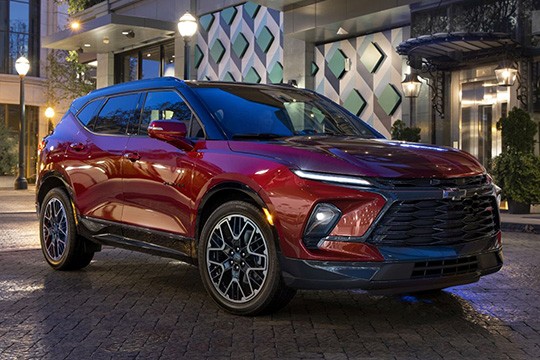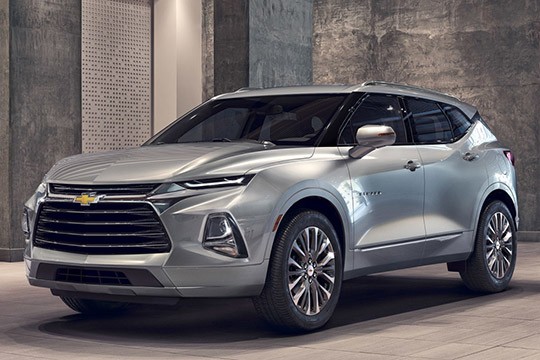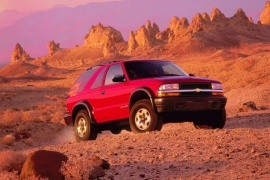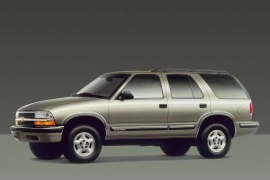CHEVROLET Blazer Models/Series Timeline, Specifications & Photos
First production year: 1995
Engines: Gasoline, Electric
Body style: SUV (Sports Utility Vehicle)
Chevrolet introduced a facelifted version for the Blazer SUV in 2022, and it improved the SUV in many areas, updating this beloved vehicle.
While there is no comparison between the 2022 Blazer and the original K5 Blazer in terms of off-road performance, there was more to say about comfort and safety. Where the modern-era Blazer shined, the former trail-warrior lacked.
General Motors installed upgraded safety systems such as Automatic Emergency Braking, Following Distance Indicator, Forward Collision Alert, Front Pedestrian Braking, Lane Keep Assist with Lane Departure Warning, and IntelliBeam automatic high beams. All these were included in the Safety Package offered on the 2022 Blazer.
From the outside, the SUV received new LED headlights, daytime running lights, and taillights. It also boasted a new front fascia, with stylized mesh-grille expanded on the lower bumper area, to the apron. It was flanked by a pair of scoops where the carmaker placed the fog lights. Another upgrade for the Blazer was for the light-alloy wheels, which were enhanced with new designs and sizes up to 21".
Inside, Chevrolet's infotainment system gained a standard 10" touchscreen placed atop the center stack. It complemented the TFT display installed inside the instrument cluster. Thus, the carmaker enriched the onboard features, enhancing the driving experience.
Under the hood, GM placed the same powertrains as before. The base version had a turbocharged 2.0-liter inline-four, while the range-topping model was the direct fuel injected 3.6-liter V6.
Even though it shares its name with the ICE-powered Blazer, the EV version was actually built on a different platform, and that helped it compete against its main rivals in the compact-SUV segment.
GM was one of the first major automakers to produce a fully-functional EV, the GM EV1, in 1996. But soon after that, it retracted and scrapped most of those cars and focused back on ICE engines. After the real EV revolution began, the American automaker was caught off-guard and didn't react too fast. Thus, it was overtaken by Ford and Stellantis (Chrysler), and only in 2022 did it show its production-ready versions of its EV-powered contenders.
At first sight, the Blazer EV looks like just another regular Blazer with a slightly different front fascia. As expected, the electron-powered SUV featured a smaller cooling area than its ICE-powered sibling. In addition, it sported Y-shaped LED headlights, continued by a light stripe towards the bow-tie badge placed between them. From its profile, the EV sported an extracting vent behind the front wheel arches, while behind the rear doors, it has a straight quarter panel towards the raked-forward tailgate.
Inside, the Blazer EV boasted two displays for the instrument panel and infotainment system. The former was an 11" TFT, while the latter was a 17.7 touchscreen. GM installed a pair of high-bolstered bucket seats at the front and a split-folding bench in the rear, fit for three passengers.
The Blazer EV was available in various trims and with different battery packs and powertrains. Thus, it could offer a range between 247 miles (397 km) for the LT version and 320 miles (515 km) for the RS trim.
Does the nameplate of „Blazer” ring any bell? Well, it should. Because Chevrolet used it before, back in the 70s.
Sure, it was not a real SUV, as SUVs were not really a thing back then. Nevertheless, the old Blazer was a great utility vehicle and a good match for users needing a ride from A to B.
The new Blazer impressed us with its aggressive look, more like the SUV version of the Camaro due to the thin headlights.
While you would expect to be able to take a SUV through a bit of mud and not have to worry, the Blazer was not exactly designed to do that. The front of the car was equipped with a nice honeycomb grille that was open. Plus, the ground clearance was not high enough.
The hood of the Blazer teamed up with the headlights to create the aggressive look by having sharp and strong lines.
Of course, the Blazer could be bought with a variety of exterior paint colors, but the RS’ design was the nicest if you ask me.
The Blazer with the RS package was built with great attention to details, such as the black finish gloss used on the outside, like the front grille, the finish trim on the bumper, the roof rails, the air diffuser at the rear and the floating roof effect.
In the cabin, the RS package gave red chrome finish on the A/C air lids, nice red leather stitchings combined with a beautiful black leather, the RS logo on the passenger’s dashboard as well as on the shifting gear knob.
As any modern vehicle, the Blazer offered Apple Car Play and Android Auto, along with a total of 6 USB ports and a wireless charging pad.
Such beauty came with no low price, users having to take over $40.000 out of their pockets.
The 1995 Blazer had the difficult mission to continue the legendary K5 lineup, which was very appreciated by the offroad community. But the Blazer three doors took a different approach.
With its rounded shapes and front independent suspension, the 1995 Blazer positioned itself right from the start as a family vehicle more than a hard-core offroad-er. GM's management considered that those who loved the K5 when they were young would appreciate the comfortable new car, which was available with a three or five-door version.
The three-door version was made mostly for empty-nesters or for those who didn't have time to make the baby-room. It looked sportier and practical as well. With the headlights separated by the turn-signals by a wide, horizontal chromed slat, its front fascia inspired more passion for roads than for trails. On its side, it featured a triangular window behind the doors with a pop-out opening system. Due to the blackened C-pillars, the greenhouse's back looked like it had a wrapped-around glass area.
Inside, the Blazer featured cloth seats with an option for velour. The 1995 model featured a steering-column mounted gear selector and a knob for the 4x4 system: 2WD, 4WD auto, and 4x4 lock. The vehicles fitted with manual transmission featured floor-mounted gear-stick and a transfer-box selector.
Under the hood, GM installed the same 4.3-liter V6 engine paired to either a four-speed automatic or a five-speed manual. Since some areas didn't require all-wheel-drive systems, GM made the SUV available with either a rear or 4x4 system. The latter featured a transfer case with high and low-range gear.
Chevrolet introduced the Blazer in 1995 as a go-anywhere SUV with some off-road abilities and good on-road behavior.
With its rounded shapes and front independent suspension, the 1995 Blazer positioned itself right from the start as a family vehicle more than a hard-core offroad-er. GM's management considered that those who loved the K5 when they were young would appreciate the comfortable new car, which was available with a three or five-door version.
The Blazer was an excellent family vehicle in the five-door version, good for a school-run or a weekend in the mountains with all family on board. It looked sportier and practical as well. With the headlights separated by the turn-signals by a wide, horizontal chromed slat, its front fascia inspired more passion for roads than for trails. Yet, it could do both. In the back, the tailgate featured an opening glass system so the owner could load it in the trunk without opening all the liftgate.
Inside, the Blazer featured cloth seats with an option for velour. The 1995 model featured a steering-column mounted gear selector and a knob for the 4x4 system: 2WD, 4WD auto, and 4x4 lock. The vehicles fitted with manual transmission featured floor-mounted gear-stick and a transfer-box selector.
Under the hood, GM installed the same 4.3-liter V6 engine paired to either a four-speed automatic or a five-speed manual. Since some areas didn't require all-wheel-drive systems, GM made the SUV available with either a rear or 4x4 system. The latter featured a transfer case with high and low-range gear.




